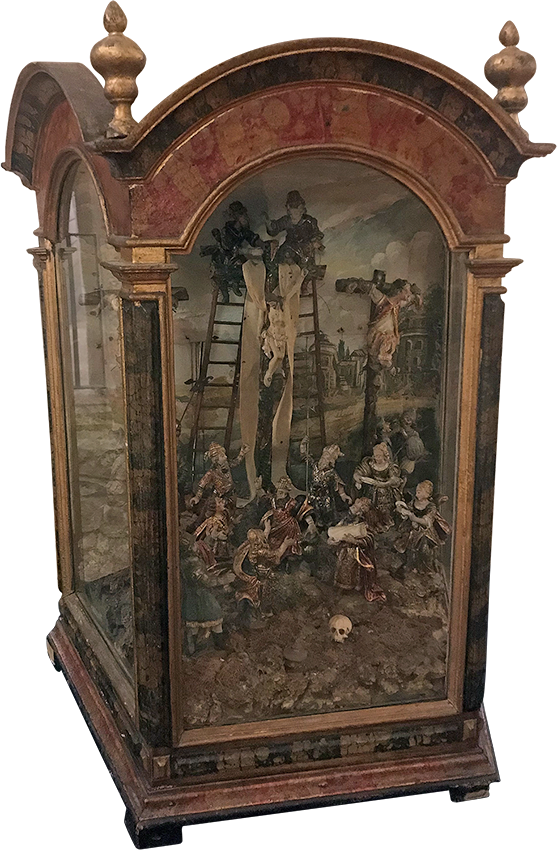This Calvary is a uniquely valuable piece of art due to the perfection and movement of figures, which expressively communicate the drama of the crucifixion and death of Jesus, through their form and gestures. The scene is inside a small, vaulted, wooden crib, with a wooden back and a painting featuring Jerusalem and three glazed faces, each one with its pediment in a polychrome and red, green and gold arch, on top of four grooved pillars separated by two golden pinecones.
It is composed of 3 raised crosses, the one in the middle being higher up, with two staircases and a white veil, the lifeless body of Jesus and the bodies of the two thieves on either side.
Jesus has his face turned to the right and looks down, his eyes facing the ground, his head of hair falling over his left shoulder; he has a moustache; his knees are flexed and each foot is secured with a nail.
The thieves are popular characters, both wearing very colourful waistcoats, shirts and trousers. Their proportions are slightly exaggerated, in comparison to the size of Jesus. They both have their arms and legs tied to the cross with ropes.
There are two soldiers on each of the two ladders on either side of Jesus. They wear turbans and vibrant, reddish clothing. They seem to be finishing the work.
The remaining figures, small, in polychrome clay between 0.09 and 0.15, represent Saint Mary and 4 more women, Joseph of Arimathea and Nicodemus, soldiers and Jews. Their stage is the cavalry with a skull.
This is an interesting theological note. Death – symbolised by the skull – puts us in communion with the crucified Jesus. But this crucifixion is a benefit to us: it represents the victory of life over death. If we die with Christ, we shall live with Him. Jesus defeated every enemy, including the greatest of all: death. Now everything points towards the “third day”.
We face a delicious, very expressive, theatrical, Baroque work. The clothes, in the fashion of the time, are dynamic, with an abundance of folds, volume and pleats; the faces speak authentically; the gestures, features and figures are greatly expressive.
A beautiful and well-conserved piece, from the eighteenth century. Chosen to help us to harmonise with 14 September, the day we commemorate the Exaltation of the Holy Cross!
Paulo Abreu
